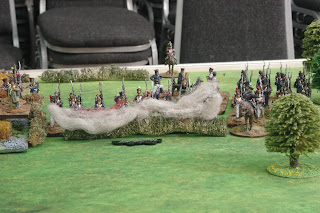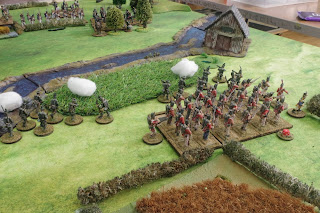Well, the Frostgrave League was much delayed by an unfortunate accident involving a staircase, an ankle and Andy, who has been running our "Find The Necromancer" series of linked scenarios. Anyway, Any is now back on both feet and the latest round of the adventure will be on 13th May. That, of course reminded me that I never wrote up the previous round, which we played back at the beginning of April.
Anyway, the scenario took our bands of treasure hunters and ne'er do wells out of the Frozen City to a location strewn with ancient ruins on the edge of some woods of bad repute. Woods in fantasy games are always of bad repute and will usually contain denizens who are unlikely to be a bunch of happy Teddy Bears having a jolly picnic and, when it comes to ancient ruins, well, the less said, the better.
This scenario had an unusual starting position. Each band was only allowed to field four of its members, each group to be led by either a Wizard, an Apprentice or a Captain. Richard, Owen and I all diced for who would do what, and I was tasked with providing my newly recruited Captain, with Richard sending the Wizard and Owen his Apprentice.
We were soon moving forwards into the unknown and the first unpleasntness to emerge was a Werewolf (here portrayed by my Werewolf from the My Last Sunrise set from Bad Squiddo). Owen's bunch of adventurers were able to see him off and things proceeded.
My group's job was to proceed to the building we could glimpse in the woods in the distance. However, on the way we were beset by a Giant Spider, but this proved to be vastly inferior to Shelob and was easily dealt with.
Advancing towards the woods, more creatures emerged, throwing javelins and disappearing, leaving me with a deceased Treasure Hunter.
I was unable to get them into combat, which was annoying, but hardly unexpected.
Finally, my Thug did manage to engage one of the things.
Elsewhere, more of them emerged and proved to be tough opponents.
Tough enough to kill my Thug, requiring the attentions of my Captain, Richard's War Hound and, eventually my Archer too.
It was clearly upset by my calling it a "horrible goblin thingy" but I did eventually kill it, but my Captain took a lot of wounds in the process.
Elsewhere, in what one can only call an Accursed Burying Ground a seriously Big Bad Thing emerged. My weakened Captain was in no shape to confront it, but Richard kindly healed some of my wounds with a spell.
It was a tough opponent, and appeared to be immune to normal weapons, but it was eventually killed, leaving Richard to discover an Enchanted Vorpal Sword among the graves.
Elsewhere, a twin Big Bad Thing was causing havoc with Owen's adventurers.
This one appeared to be immune to Magic, so I sent in my Captain, and she proceeded to go into battle against the vile beast. Eventually, the BBT fell to a combined attack from myself and Owen.
Unhappily, my Captain was then set upon by evil Hounds, but by now the game was over, because we had the Enchanted Vorpal Sword, so we called it a day.
In the next round, I will be supplying the Wizard, so I am hoping that Ermengarde the Elementalist will prove to be a success and not get herself killed.
In the post-game accounting, my Treasure Hunter emerged unscathed, but my Thug was permanently dead.

















































